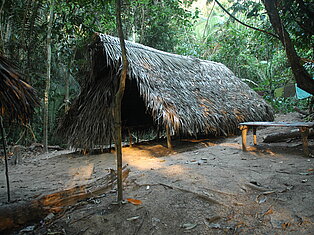Opening hours: Wednesday-Friday 9 a.m.-5 p.m., Saturday and Sunday 10 a.m.-5 p.m.
Admission: regular 100 CZK, reduced 60 CZK, family 200 CZK
The exhibition showcases the cultural and natural diversity of the Greater Amazon and provides an insight into the lives of the indigenous people of this vast and varied region. The exhibition offers aperspective that is different from the typical European-centered view, as it provides space to the indigenous communities to share their own self-representations. It should be mentioned that members of local ethnic groups had a significant role in the preparation of the exhibition. Visitors will thus learn about their rich culture, understanding of nature, mythology, religion, cosmology and interpretation of the world, customs, and rituals.
The exhibition focuses on a number of core themes, with each theme represented by original exhibits from private collections. These include everyday objects, handicrafts, weapons, ritual and ceremonial artefacts, amulets, clothing, ornaments and various accessories. The exhibition is further enriched with photographs, paintings and handicrafts by contemporary indigenous artists and artisans, including video documentation depicting the process of production, as well asdescriptions of the meaning of the artefacts. The symbolism of patterns, colours and materials is also explained.
Ethnic groups from Peru, Ecuador, Colombia, Venezuela and Brazil are presented in this context, among them the Shuar, Achuar, Kofán, Huaorani/Waorani, as well as the Shipibo-Konibo, Cashinahua, Ticuna, Tucano, Yanomami and many others. The exhibition also presents selected myths and stories from the Amazon in print, audio and video animation. Nature, biodiversity, and closely related issues, such as ecology and environmental issues, are another important topic of the exhibition.
Typical animals from the Amazonian forest are depicted using aspecial sound system and a video presentation. The dermoplastic recostructions of various animals will be complemented by Jan Dungel's illustrations. Visitors can also look forward to live exhibits of fruits, specimens of woody plants, and other natural objects.
The exhibition is intended for a wide range of visitors. Texts dealing with the themes of the exhibition are available via QR codes in English and Spanish. A Czech audioguide is also available.
Children can enjoy the interactive elements of the exhibition, such as replica objects, sensory games, toys, arts and crafts, and a set of worksheets with a range of fun activities.
The exhibition is designed to be as inclusive as possible. For visitors with visual impairments, the main points are presented in Braille descriptions. Moreover, the exhibition includes a variety of tactile elements, haptic objects, maps, a model of a traditional shabono, olfactory sensations, and interactive activities, such as a haptic memory game.
A video guide in Czech sign language is available for deaf visitors.
The exhibition offers an unusual view of contemporary Amazonia that can be experienced with all the senses.
Thanks to cooperation with international institutions and experts involved, the indigenous people themselves have been given the opportunity to present their society and culture from their own perspective. Visitors thus get a unique opportunity to view life in the Amazon through the eyes of its inhabitants.
A Thousand Faces of the Amazon is a space for intercultural dialogue. It is a project of many collaborating institutions, of which the main partner is the Masaryk University Language Centre. Other partners are the National Museum - Náprstek Museum of Asian, African and American Cultures, the Teiresias Centre for Assistance to Students with Specific Needs at Masaryk University, the Faculty of Informatics of Masaryk University, ZUŠ Smetanova, the Secondary School of Art and Design and Higher Professional School Brno, Zoo Brno, and the Centre of special interests groups.
Among the foreign institutions that contributed to this exhibition are Universidad del Azuay,and Universidad Politécnica Salesiana (Ecuador), Universidad Científica del Sur (Peru), and Bournemouth University (UK). The exhibition also features photographs and recordings from Masaryk University's EPSULA project. The photographs by Shipibo artist David Díaz were provided by the Embassy of the Republic of Peru in Prague.
The main authors of the exhibition are Athena Alchazidu, a Hispanist from Masaryk University in Brno, and Narcisa de Jesús Ullauri Donoso, an anthropologist from the Universidad del Azuay in Ecuador, who is also the guarantor of the exhibition. The English commentaries were edited and proofread by Joe Lennon of the Masaryk University Language Centre.
The exhibition includes unique photographs from the archives of Czech researchers and travellers, such as the ethnographer and writer Mnislav Zelený Atapana, and the ethnobotanist Jana Horáčková. Some originals from the 19th and 20th centuries are loans from the National Museum - Náprstek Museum of Asian, African and American Cultures.
The exhibition is accompanied by a number of special programmes designed for visitors of all ages. There are art and craft workshops, educational programmes for elementary and secondary schools and leisure organisations, as well as special lectures for the general public.
The exhibition is organised under the auspices of:
- Mgr. Martin Baxa
Minister of Culture of the Czech Republic
- JUDr. Markéta Vaňková
Mayor of the Statutory City of Brno
- Prof. MUDr. Martin Bareš, Ph.D.
Rector of Masaryk University
- Néstor Popolizio
Ambassador of Peru to the Czech Republic
- Sônia Regina Guimarães Gomes
Ambassador of Brazil to the Czech Republic
- Pavla Havrlíková
Ambassador of the Czech Republic to Brazil







